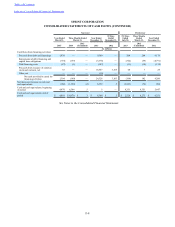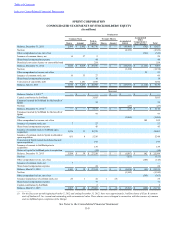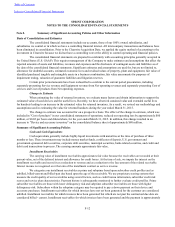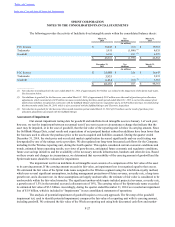Sprint - Nextel 2014 Annual Report Download - page 101
Download and view the complete annual report
Please find page 101 of the 2014 Sprint - Nextel annual report below. You can navigate through the pages in the report by either clicking on the pages listed below, or by using the keyword search tool below to find specific information within the annual report.
Table of Contents
Index to Consolidated Financial Statements
SPRINT CORPORATION
NOTES TO THE CONSOLIDATED FINANCIAL STATEMENTS
F-18
performance-based restricted stock units are not entitled to dividend equivalent payments until the applicable performance
and service criteria have been met. During the Successor year ended March 31, 2015, the Company granted approximately 6
million service only and performance-based restricted stock units with a weighted average grant date fair value of $7.39 per
share. At March 31, 2015, approximately 17 million restricted stock unit awards were outstanding.
Compensation Costs
The cost of employee services received in exchange for share-based awards classified as equity is measured using
the estimated fair value of the award on the date of the grant, and that cost is recognized over the period that the award
recipient is required to provide service in exchange for the award. Awards of instruments classified as liabilities are measured
at the estimated fair value at each reporting date through settlement.
Pre-tax share and non-share based compensation charges from our incentive plans included in net loss were $86
million, $35 million and $98 million for the Successor year ended March 31, 2015, the three-month transition period ended
March 31, 2014, and the year ended December 31, 2013, respectively, and $37 million, $17 million and $82 million for the
Predecessor 191-day period ended July 10, 2013, unaudited three month-period ended March 31, 2013 and year ended
December 31, 2012, respectively. The net income tax benefit (expense) recognized in the consolidated financial statements
for share-based compensation awards was $34 million, $12 million and $34 million for the Successor year ended March 31,
2015, the three-month transition period ended March 31, 2014 and year ended December 31, 2013, respectively, and $2
million, $(1) million and $14 million for the Predecessor 191-day period ended July 10, 2013, unaudited three-month period
March 31, 2013 and year ended December 31, 2012, respectively. As of March 31, 2015, there was $76 million of total
unrecognized compensation cost related to non-vested incentive awards that are expected to be recognized over a weighted
average period of 1.75 years.
Advertising Costs
We recognize advertising expense when incurred as selling, general and administrative expense. Advertising
expenses totaled $1.5 billion, $408 million and $697 million for the Successor year ended March 31, 2015, the three-month
transition period ended March 31, 2014 and year ended December 31, 2013, respectively, and $858 million, $409 million and
$1.4 billion for the Predecessor 191-day period ended July 10, 2013, the unaudited three-month period March 31, 2013 and
year ended December 31, 2012, respectively.
New Accounting Pronouncements
In April 2014, the Financial Accounting Standards Board (FASB) issued authoritative guidance regarding
Reporting of Discontinued Operations and Disclosures of Disposals of Components of an Entity, which changes the criteria
for determining which disposals can be presented as discontinued operations and modifies related disclosure requirements.
The updated guidance defines discontinued operations as a disposal of a component or group of components that is disposed
of or is classified as held for sale and represents a strategic shift that has, or will have, a major effect on an entity’s operations
and financial results. Additionally, the disclosure requirements for discontinued operations were expanded and new
disclosures for individually significant dispositions that do not qualify as discontinued operations are required. The guidance
is effective prospectively for fiscal years and interim reporting periods within those years beginning after December 15, 2014,
with early adoption permitted for transactions that have not been reported in financial statements previously issued or
available for issuance. The standard will be effective for the Company's fiscal year beginning April 1, 2015 and will be
applied to relevant future transactions.
In May 2014, the FASB issued new authoritative literature, Revenue from Contracts with Customers. The issuance
is part of a joint effort by the FASB and the International Accounting Standards Board (IASB) to enhance financial reporting
by creating common revenue recognition guidance for U.S. GAAP and International Financial Reporting Standards and,
thereby, improving the consistency of requirements, comparability of practices and usefulness of disclosures. The new
standard will supersede much of the existing authoritative literature for revenue recognition. As currently written, the
standard and related amendments will be effective for the Company for its annual reporting period beginning April 1, 2017,
including interim periods within that reporting period, and early application is not permitted. In April 2015, the FASB issued
a proposal to defer the effective date of the new literature by one year but allow companies to early adopt according to the
original effective date. Entities are allowed to transition to the new standard by either retrospective application or recognizing
























